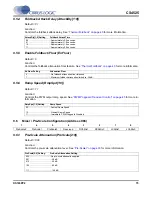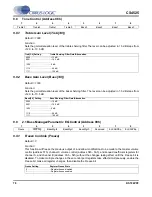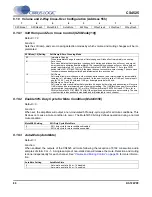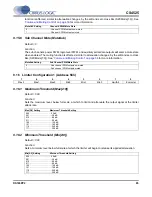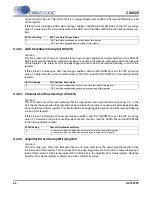
80
DS726PP2
CS4525
9.10
Volume and 2-Way Cross-Over Configuration (Address 55h)
9.10.1
Soft Ramp and Zero Cross Control (SZCMode[1:0])
Default = 10
Function:
Sets the soft ramp and zero crossing detection modes by which volume and muting changes will be im-
plemented.
9.10.2
Enable 50% Duty Cycle for Mute Condition (Mute50/50)
Default = 0
Function:
When set, the amplifiers will output a non-modulated 50%-duty-cycle signal for all mute conditions. This
bit does not cause a mute condition to occur. The Mute50/50 bit only defines operation during a normal
mute condition.
9.10.3
Auto-Mute (AutoMute)
Default = 1
Function:
When enabled, the outputs of the CS4525 will mute following the reception of 8192 consecutive audio
samples of static 0 or -1. A single sample of non-static data will release the mute. Detection and muting
is done independently for each channel. See
“Volume and Muting Control” on page 36
for more informa-
tion.
7
6
5
4
3
2
1
0
SZCMode1
SZCMode0
Mute50/50
AutoMute
En2Way
2WayFreq2
2WayFreq1
2WayFreq0
SZCMode[1:0] Setting
Soft Ramp & Zero Crossing Mode
00 ........................................ Immediate Change
When immediate change is selected, all level changes will take effect immediately in one step.
01 ........................................ Zero Cross
Zero cross dictates that signal level changes, both muting and attenuation, will occur on a signal
zero crossing to minimize audible artifacts. The requested level change will occur after a timeout
period (approximately 18.7 ms for a PWM switch rate of 384/768 kHz and 17.0 ms for a PWM
switch rate of 421.875/843.75 kHz) if the signal does not encounter a zero crossing. The zero cross
function is independently monitored and implemented for each channel.
10 ........................................ Soft Ramp
Soft ramp allows level changes, both muting and attenuation, to be implemented by incrementally
ramping, in ½ dB steps, from the current level to the new level at a rate of ½ dB per 4 sample peri-
ods for 32, 44.1, and 48 kHz, and ½ dB per 8 sample periods for 96 kHz.
11......................................... Soft Ramp on Zero Cross
Soft ramp on zero cross dictates that signal level changes, both muting and attenuation, will occur in
½ dB steps and be implemented on a signal zero crossing. The ½ dB level change will occur after a
timeout period (approximately 18.7 ms for a PWM switch rate of 384/768 kHz and 17.0 ms for a
PWM switch rate of 421.875/843.75 kHz) if the signal does not encounter a zero crossing. The zero
cross function is independently monitored and implemented for each channel.
Mute50/50 Setting
50% Duty Cycle Mute State
0 .......................................... 50% duty cycle for mute conditions disabled.
1 .......................................... 50% duty cycle for mute conditions enabled.
AutoMute Setting
AutoMute State
0 .......................................... Auto-mute on static 0’s or -1’s disabled.
1 .......................................... Auto-mute on static 0’s or -1’s enabled.










